Key Points:
- While the Western Pygmy Rattlesnake does not live on the extreme eastern border of Arkansas, and the Western Diamondback Rattlesnake lives only in West-Central Arkansas, the Timber Rattlesnake can be found anywhere in the state. That’s unfortunate since the Timber Rattlesnake is the most venomous snake in the United States!
- In size, the Western Pygmy is, as one would expect from its name, the smallest of these three rattlesnakes, with the Western Diamondback being the largest.
- These rattlers are not only colorful in appearance but also in their nicknames: Western Pygmy rattlesnakes are also called “Ground Rattlers” or simply “Pigs (Pygs),” the Western Diamondback is called the “Coon-Tail Rattler,” and the Timber Rattlesnake is also known as a “velvet-tail rattler.”

Arkansas is home to 40 species of snakes, six of which are venomous, with three of them being rattlesnakes.
©iStock.com/daboost
Arkansas is home to at least 40 different species of snakes. Most snakes are found in wooded areas throughout the state, and some are rarely encountered by humans. Human-snake encounters primarily occur during the snakes’ mating season, in the summer and the early fall.
It is illegal to kill any of these snakes in Arkansas, whether venomous or non-venomous. However, only six of these snake species are venomous. Three of these dangerous species are rattlesnakes. What types of rattlesnakes live in Arkansas? Where are they found? What do they look like? Let’s look at the three types of rattlesnakes in Arkansas.
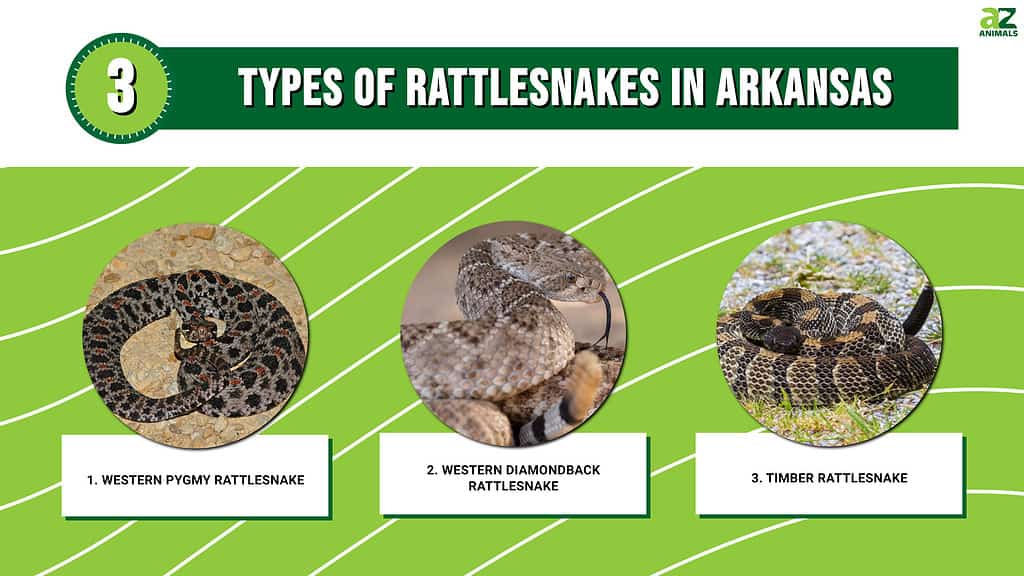
1. Western Pygmy Rattlesnake
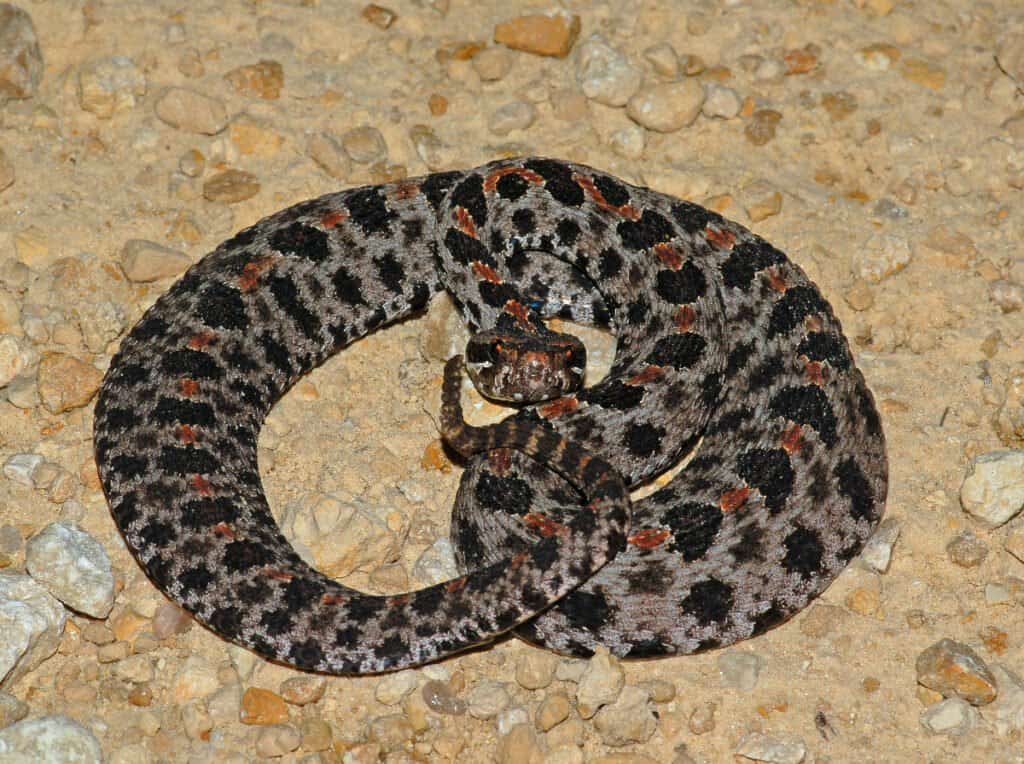
The Western Pygmy Rattlesnake has a small rattle that sounds like buzzing insects.
©Gerald A. DeBoer/Shutterstock.com
| Western Pygmy Rattlesnake | Details |
|---|---|
| Range | All of Arkansas except for the extreme eastern border |
| Length | 15-20 inches |
The colorful Western Pygmy Rattlesnake lives all throughout Arkansas, except for the extreme eastern border of the state. These snakes are often found within a few miles of water, like lakes and rivers. Western pygmy rattlesnakes are slate gray or light gray with an orange stripe running along the top of their bodies, although some snakes lack this orange stripe. These snakes have black spots along their backs and sides. They also have black markings on the tops of their heads and along both cheeks. Young pygmy rattlesnakes have bright yellow or green tails. The young snakes twitch their colored tails to lure in prey like lizards and frogs.
Western pygmy rattlesnakes are the smallest of Arkansas’ venomous snakes. These snakes are usually between 15 and 20 inches long with small, slender tails. Their small tails are tipped with a rattle so small that it can usually be heard from only about a yard away, at most, and it sounds like buzzing insects. In Arkansas, western pygmy rattlesnakes are also called “Ground Rattlers” or simply “Pigs.” These snakes do not produce a large amount of venom, but they are cytotoxic and can still be quite harmful. They eat small mammals and birds, lizards, frogs and insects including giant desert centipedes.
2. Western Diamondback Rattlesnake

As the largest venomous snake, you don’t want to mess with Western diamondback rattlesnakes.
©Alexander Wong/Shutterstock.com
| Western Diamondback Rattlesnake | Details |
|---|---|
| Range | West-Central Arkansas, in the southwest regions of the Ozarks & Ouachita Mountains |
| Length | 48-84 inches |
Found in West-Central Arkansas, the Western Diamondback Rattlesnake lives mainly in the southwest regions of the Ozarks and the Ouachita Mountains. However, these snakes are found only in small pockets, and it is unknown exactly how many are left in Arkansas. It is rare for humans to see western diamondback rattlesnakes in Arkansas. When humans do encounter these tenacious rattlesnakes, however, they often harm or kill the snakes unnecessarily.
The diet of the Western Diamondback is similar to that of the Timber Rattlesnake: Mice, rats, rabbits, gophers, ground dwelling birds, lizards, and other small animals.
This snake is the least common venomous snake in the state. It is also the largest venomous snake, growing between 48 and 84 inches long. Its most distinctive feature is the bordered “diamond” markings (from which it gets its name) lining the middle of its back and running down the length of its body. This snake is usually grayish-brown or light brown. Its tail ends with black and white or pale gray bands just before the rattle, which is why it is sometimes called a “Coon-Tail Rattler.” This snake is also referred to as a “D’back” or “Atrox” in Arkansas.
3. Timber Rattlesnake

The most venomous snake in the U.S. is the Timber Rattlesnake.
©Frode Jacobsen/Shutterstock.com
| Timber Rattlesnake | Details |
|---|---|
| Range | All of Arkansas |
| Length | 36-60 inches |
Found throughout the state, the Timber Rattlesnake prefers western and southern facing slopes. This snake is most commonly found from April through October, although human encounters with it are unusual anytime. Timber rattlesnakes live in and near forests, woodlands, swamps, floodplains, and agricultural areas in Arkansas. These snakes primary eat small mammals like rodents, shrews, rabbits, gophers, squirrels, and chipmunks. Sometimes timber rattlesnakes can be found climbing trees in search of birds.
Timber rattlesnakes are 36-60 inches long, with dark “V”-shaped bands along the length of their bodies. Their base color is usually yellow-brown, tan, or gray. Some timber rattlesnakes in Arkansas are so dark that they look almost completely black. Other snakes also have a colored stripe running along the middle of their backs in shades of brown, orange, pink, and even black. This stripe gives them a similar appearance to a pygmy rattlesnake. However, timber rattlesnakes are bigger, and their tail is completely black. This black tail is why these snakes are often called “velvet-tail rattlers.”
The colors and patterns of timber rattlesnakes act as excellent camouflage. When the snake coils low on the ground or buries itself in leaves and forest litter, it can be nearly invisible. These snakes are not very aggressive and do not always rattle, so you may end up quite close to one without realizing it! Timber rattlesnakes are relatively calm, but they are one of the most dangerous rattlesnakes in North America. It is important to be careful anytime you are in an area where these snakes may be living. Most timber rattlesnake bites in Arkansas occur during hunting season around August and September, when hunters fail to see these inconspicuous snakes.
Other Common Snakes in Arkansas
Arkansas is home to at least 40 types of snakes. Here are just a few examples of some of the nonvenomous snake species living in Arkansas.
Western Rat Snake
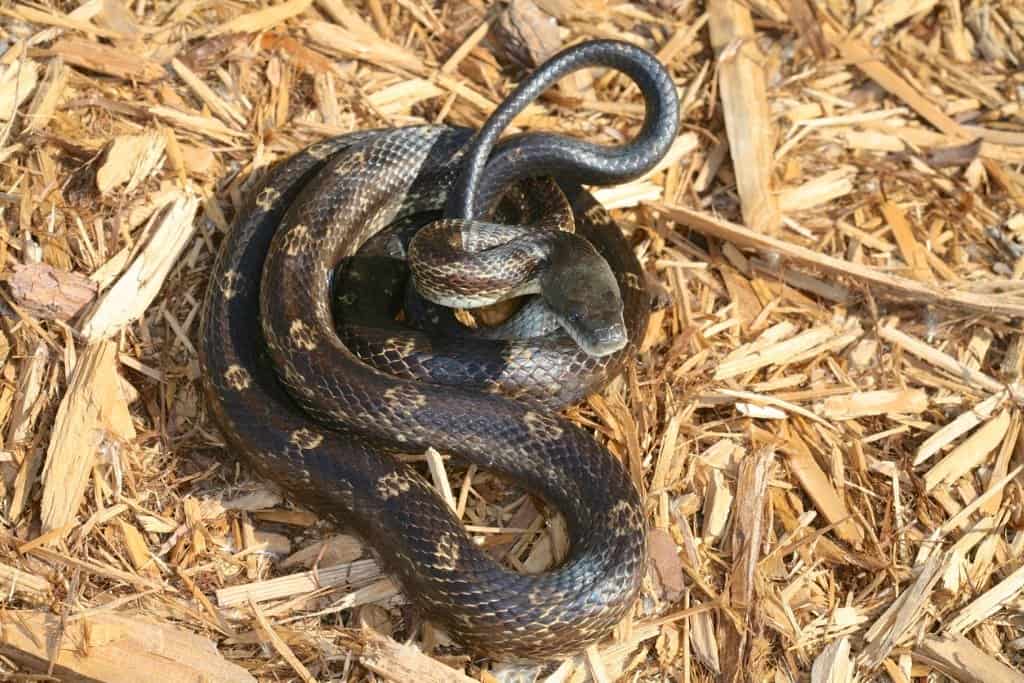
Darkening as they mature, Western Rat Snakes lose some of the pattern on their heads and bodies.
©iStock.com/Naja Shots
| Western Rat Snake | Details |
|---|---|
| Range | All of Arkansas |
| Length | 42-72 inches |
Found throughout Arkansas, the Western Rat Snake is one of the most common snakes found in the state. These snakes are mostly black, with white or cream on their throats and bellies. They are often called “Black Rat Snakes” because of this dark coloring. Young western rat snakes are light-colored with large dark irregular splotching. They do not obtain the solid black color until they are two to five years old.
Western rat snakes are non-venomous constrictors, and contrary to their name, they do not only eat rats. They also eat many other small mammals, birds, and bird eggs. Western rat snakes living near farms are often called “Chicken Snakes” because chicken eggs and chicks are some of their favorite things to eat.
Ring-Necked Snake
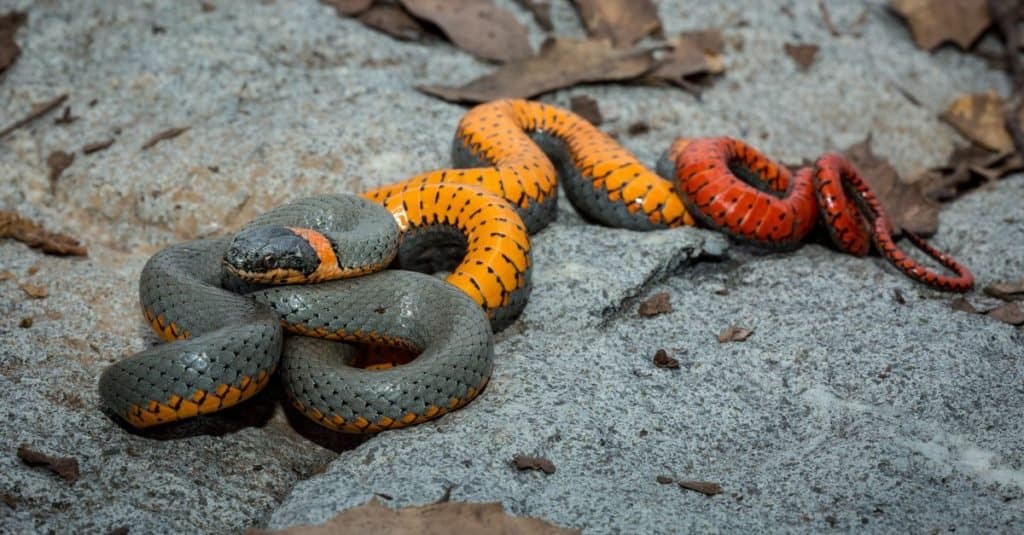
Ringneck Snakes will play dead when threatened.
©Michael K. McDermott/Shutterstock.com
| Ring-Necked Snake | Details |
|---|---|
| Range | All of Arkansas |
| Length | 12 inches or less |
The Ring-Necked Snake lives throughout Arkansas, usually hiding in protective covers like soil, rocks, tree litter, and other debris. These non-venomous snakes are very small and secretive, although they are commonly found in gardens. Ring-necked snakes grow up to 12 inches long, with thin bodies that are no bigger than the width of a pencil. The top portion of the snake is grey, brown, or black, sometimes with undertones of blue or green. Their underbellies, on the other hand, are bright and colorful, with shades of red, yellow, and orange. The ring-necked snake gets its name from the brightly colored “ring” marking around its neck that matches its underbelly. These colors are a warning to potential predators, signaling that the snakes will not be very tasty.
Speckled Kingsnake
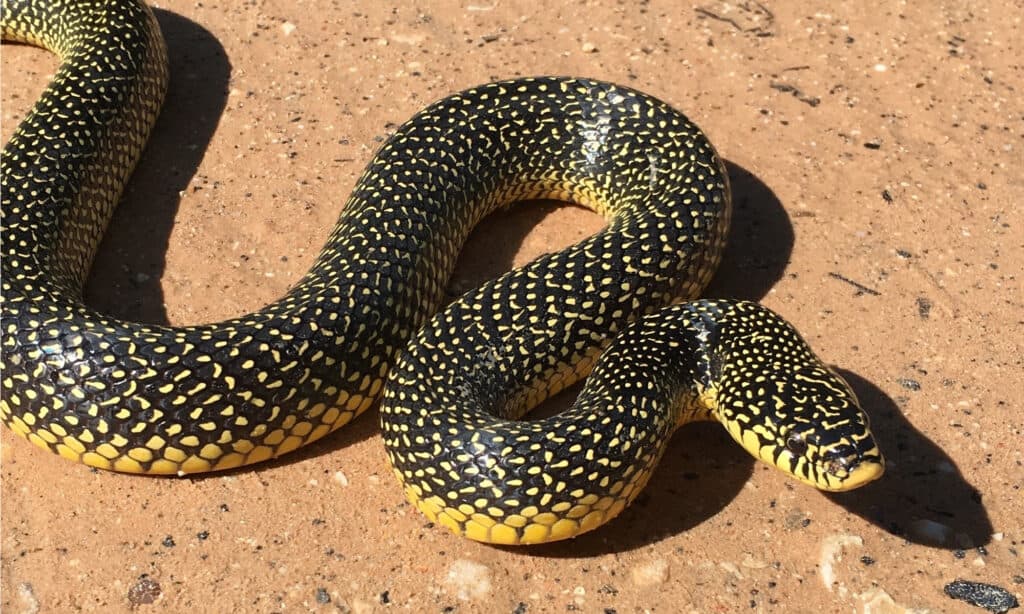
The largest
Speckled Kingsnake
recorded was 72 inches long.
©Joe Farah/Shutterstock.com
| Speckled Kingsnake | Details |
|---|---|
| Range | All of Arkansas |
| Length | 36-48 inches |
The Speckled Kingsnake lives throughout Arkansas in a variety of habitats. It is an elegant blue-black snake with yellow “speckles” sprinkled across the length of its body. The combination of its blue-black coloring and its yellow spots often makes the snake appear dark green. This snake is sometimes also called a “Salt-n-Pepper Snake” or a “Flecked Snake.” The speckled kingsnake is usually around 48 inches long and is a non-venomous constrictor.
Northern Rough Green Snake

The Northern Rough Green Snake has rough scales that make it easy to climb trees.
©iStock.com/BobMcLeanLLC
| Northern Rough Green Snake | Details |
|---|---|
| Range | All of Arkansas |
| Length | 14-45 inches |
The Northern Rough Green Snake lives across the entire state of Arkansas. It is an “arboreal snake,” which means that it spends most of its time in trees and bushes, usually two to five feet above the ground. The rough green snake is small and wiry, with a very thin body that measures 14-45 inches in length. These snakes are vibrant, with solid green backs and yellow-green- or cream-colored bellies, allowing them to blend in with their leafy habitats. They also have keeled scales with ridging, which gives their bodies a rough texture. Northern rough green snakes are non-venomous, and they are the only snakes in Arkansas that are specifically insectivores; that is, they eat only insects and spiders.
Black Snakes in Arkansas
If you want to get more specific and study only the black snakes in Arkansas, click on this link or on the article below devoted to the following snakes: the Northern Cottonmouth, the Southern Black Racer, the Black Rat Snake, the Coachwhip Snake, the Ribbon Snake, the Western Mud Snake, Graham’s Crayfish Snake, the Western Worm Snake, the Ringneck Snake, the Flathead Snake, the Plainbelly Water Snake, and the Common Garter Snake.
Some interesting facts about these snakes:
- Some black snakes have other colors on their underbellies like the Garter Snake, Plainbelly Water Snake, and Graham’s Crayfish Snake that all have yellowish/cream underbellies. Mud Snakes and the Western Worm Snake have red bellies.
- The Garter Snake, the Plainbelly Water Snake, and the Flathead Snake all have poisonous saliva, but they do not inject venom.
- Diets vary among these black snakes and one difference is that the Ringneck and the Ribbon snakes will eat earthworms, and the Western Worm Snake will eat only earthworms.
Summary of 3 Types of Rattlesnakes in Arkansas
Here’s a recap of the three rattlesnake species found in Arkansas that we took a look at:
| Number | Snake | Range | Length |
|---|---|---|---|
| 1 | Western Pygmy Rattlesnake | All of Arkansas except for the extreme eastern border | 15-20 inches |
| 2 | Western Diamondback Rattlesnake | West-Central Arkansas, in the southwest regions of the Ozarks & Ouachita Mountains | 48-84 inches |
| 3 | Timber Rattlesnake | All of Arkansas | 36-60 inches |
What State Has the Most Snake Attacks?

The venomous cottonmouth snake is among the snakes responsible for snake bites in North Carolina.
©Marcum Havens/Shutterstock.com
Arkansas ranks third in the U.S. for snake bites per year, averaging 92.9 bites per million population. But what state ranks the highest in snake bites? That would be North Carolina. This southeastern state’s bite rate is 157.8 bites per million population per year. How does that average out? Well, the population as of 2021 was a little over 10 million (10.55 to be exact). If we were to just figure it off of 10 million, that would mean that there are roughly 1,580 reported snake bites per year.
The top 6 states for reported snake bites are as follows:
- North Carolina–157.8 bites per million
- West Virginia–105.3 bites per million
- Arkansas–92.9 bites per million
- Oklahoma–61 bites per million
- Virginia–48.7 bites per million
- Texas–44.2 bites per million
In North Carolina, there are 6 different kinds of venomous snakes: copperhead, cottonmouth, timber rattlesnake, pigmy rattlesnake, eastern diamondback rattlesnake, and eastern coral snake. In 2019, 92 people were bitten by venomous snakes in that state.
The photo featured at the top of this post is © Gerald A. DeBoer/Shutterstock.com
Discover the "Monster" Snake 5X Bigger than an Anaconda
Every day A-Z Animals sends out some of the most incredible facts in the world from our free newsletter. Want to discover the 10 most beautiful snakes in the world, a "snake island" where you're never more than 3 feet from danger, or a "monster" snake 5X larger than an anaconda? Then sign up right now and you'll start receiving our daily newsletter absolutely free.
Thank you for reading! Have some feedback for us? Contact the AZ Animals editorial team.






